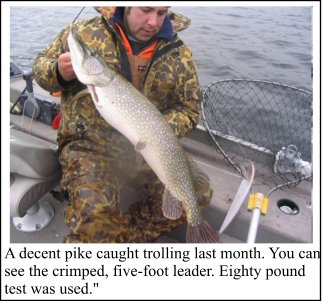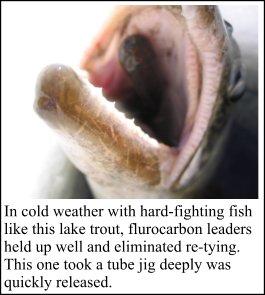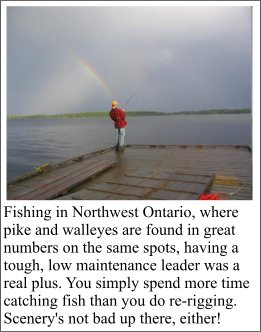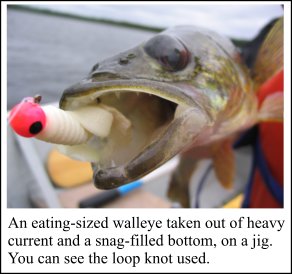I Tried Fluorocarbon
Leaders. About this time last year, I decided to really start experimenting with fluorocarbon leaders. I wanted to see how well the stuff held up, and if there really were any noticeable advantages. I picked up a few spools from different manufacturers, and started tying them and fishing them right away. Once muskie season opens, that's all I fish for. But from ice-in until the end of June, I used my new leaders for everything from lakers to crappie, from four to eighty pound test. My experiment actually got off the ground two years ago, when my buddy Adam Smith left a twelve inch, ninety pound muskie leader in my boat for me to try one fall. It made the trip with me to Northwest Ontario where I worked as a fishing guide for a season, and was involved in about three hundred pike, from 30 to 46 inches up there alone. I still use it today. Fluoro's stiff, and has a hard skin. It also has less stretch than monofilament line. Most of the talk surrounding it deals with its low visibility under water, but its durability won me over right away. It's tough to break. It's a bad habit, but I can bite through fifty pound mono with my teeth, with next to no effort. Fluoro one-fifth that weight is a challenge. There are lots of fishermen who really pay close attention to how their line shows up to the fish, and I have no doubt that in a few cases, it's a big consideration. There are places I fish where the water is very clear, but I've never blamed or credited line visibility to any success or tough times I've had. Some guys will tell you the total opposite.
Anyone who's fished with me knows that jigs, spring, walleyes and big pike is one of my favorite combinations. In Northwest Ontario as well as locally, my leaders wore down some good pike. Some of which had the jig well inside their mouths. I used to use Seventrand wire for all my pike jigging (winter, too) in eighteen pound test. Fluoro adds more action I think, but is nowhere near as tough. You hook a big pike on spinning tackle around current, you're taking it easy no matter what kind of leader you're using. You can pull it off with fluoro if you do it right. Through the ice for lake trout, pike, herring, walleyes or panfish, the same basic set-up all worked great for jigging lures. Mainline to a swivel to the leader. For pure vertical fishing, I only used a swivel connection, no knots. Four pound worked great for walleyes, herring and perch, fifteen for lakers and forty for some of the larger pike baits, like Jigging Rapalas and larger spoons. A regular loop knot is what I use to tie on jigging lures. With dropper rigs for perch, the added stiffness of fluoro was nice, for keeping the top bait out and away from the mainline. One of my favorite rigs consists of a little, heavy, baited Genz worm jig on the bottom and a tiny, Tru-Turn cricket hook about ten inches above that, at a right angle to the mainline. We also fish a lot of slip bobbers through the ice, and 2006 was a weird year for pike and walleyes to say the least. The weather was usually horrible, and the bite tough. Small, live minnows anchored to ¼ ounce jigs fished on fifteen pound leaders was our most consistent presentation for pike over thirty inches all winter. Walleyes liked it, too. We set the hook very fast to avoid deeply hooking them, but there were more than a few trips where fluoro's extra muscle helped us land fish and control them around the hole. With suckers and other minnows less than five inches long, it doesn't take a good pike long to get it past the lips and into trouble. Our biggest of the winter was about a thirty seven incher, and she had the small, #6 hook buried across the teeth. We got the whole fight on video, and we won it.
For lakers and rainbows at ice-out, my leaders really got a chance to make it or break it. The fishing is normally pretty good, and on the average weekend, I can normally bank on releasing twenty to sixty fish, from two to twenty pounds. We made up ten and fifteen pound leaders for both the flatline/trolling board rods (eight to thirteen foot steelhead-action spinning and casting stuff) and the heavier gear used to troll the two largest-size Dipsey Divers or Deep Sixes. We do a fair bit of casting at that time, too, and used fluoro there also. On the flatlines, behind a good swivel or a keel weight, a three foot lead held up great. Behind the diving planers, sixty inches of fifteen pound was what we used. On the business end was normally a small, light snap, because we change baits a lot when trout fishing. (So many baits work and that time, and it's fun to experiment).
The proof was in the pudding: we didn't change leaders at any point from April 9th until June 15th, and released about three hundred fish. Equal numbers of trout were caught suspended as when clipping rock/sand structure. Lakers roll, and lakers fight. It might not be as rough as flipping for largemouth or power trolling big baits for muskies, but those leaders had a lot of abuse thrown their way, trust me. After a trip, long leaders were usually wound around the body of casting reels or chunks of cardboard for storage. Other times, we'd simply ball them up and drop them into a storage box. Because they're so stiff and durable, unwrapping them to use later is really simple. They rarely tangled. Would you believe that those same leaders got cut in half and then used for smallmouths in July? I took a week off right around Canada Day, and had a friend up from Kentucky for five days. She'd never fished in her life, and on all but one evening, it was way too rough to run down Georgian Bay to fish muskies, so we spent a week bassin', close to the launch. Cabbage is at its prime on the Bay at that time, and smallies absolutely love it. That's where we caught most of them. (On the rocks and a few suspended, too). I rigged her up with a two-foot section of ten pound off a swivel and a green cammo garlic tube and then played cameraman every morning and evening. Loop knot to the jig and a whole lot of bass. We pulled off rocks, ripped weeds and filled the boat for five solid days with smallies to 5.9 pounds. I didn't even think about retying once. The only time I did was when I had to replace a chewed and ripped tube body. Jenny's first fish of her life was about a 19 inch smallie that fought like it was hooked up to the trolling motor battery.
For pike, my old, ninety pounder is still in the line up, and it still holds up great. It's scuffed, knicked and kind of milky white, but I have no doubt about its strength. She's solid at the crimps and in surprisingly good shape. On small, pull-rise jerkbaits like nine inch Suicks, it definitely makes the bait run shallower. Up around Red Lake, Connie Inman from Tennessee showed me a surface-fishing pattern for big pike near slack-water reed beds in rivers on Suicks that was head and shoulders above any other way you could try working that lure. The bulky leaders were great. Belly flop the flat-bottomed lure out, and leave it. They'll come get it. I obviously tied my lighter leaders for other species with normal loop and clinch-type knots, but the eighty pound is a lot thicker, a lot stiffer and more difficult to wrap, thread and boss around in general. I used single and double barreled crimps as I also had great success using the same loop-type knots, which surprised me. The score was dead even: I caught two muskies over 45 inches on leaders I tied, and two more on leaders I crimped. My two most telling experiences were months and miles apart, but I won't forget either. Not long after Opening Day, I got about a 43 on the French River on a jerkbait in a figure eight that went around and around for at least five minutes. The muskie took the lure ten inches from the rod tip, in heavy, slop weeds and I really had to lean on her. I won that one, too. Three weeks ago, I lucked into a fat little pike about 35 inches long over open water on one of my trolling leaders. The fish hit and fought hard, but that isn't the whole story. An hour later, I stuck the same 13 inch lure into a shoal a mile away at five miles an hour, going down-wind, and literally stopped my seventeen foot boat dead in its tracks. That leader has crimps on both ends. A year earlier, on the same spot, my buddy Raf Kraskeiwicz deadlifted a twenty five pound navy anchor off the same shoal with one of his leaders. Had it not been a $100 lure on the end of the line, we wouldn't have invested all that time reefing on the line. It was pretty incredible. On all my pike and muskie leaders, I use a bearing or barrel swivel on the top and a split ring on the bottom. No snaps. Loop-knots are far better to tie and to rig on a split ring than a clinch knot, and I finish them all with a dab of superglue. I doubt it helps, but hey, it's a long winter and the muskie itch never really goes away. You'll need a lot of pressure to cinch the knot down, and moisten it well, with either saliva or an oil-based fish scent. I drive a heavy nail into a chunk of 2x4, and set it into a shop vise. On trips, a dead tree or picnic table also works. Wrap the nail in electric tape, and pull against that. Lock a pair of vise grips onto your tag end, and set her down tight! I'm sure everyone has their own tricks and methods. Finish the tag of the knot close, and burn it flat with a lighter. I still use the wire leaders I make for deep, rock-pounding trolling on my heavier gear and wire line outfits for pike and muskie. They're two hundred pound, single strand wire. After seeing Raf's trick pulling that anchor in, I just might really put the fluoro to the test on a wire rod next year. I'll definitely step up to 130# or greater. Wire's tough on slime and scales when fish roll, and I really like the idea of a softer leader for Catch & Release, especially in warmer weather. For certain, fluoro's efficient to use. You'll retie less, and you'll lose less tackle when it comes to jigs or livebait rigs. I tried some snelled spinner rigs behind bottom bouncers that I tied with twenty pound material and I bent a couple hooks open, after hanging up. Less wear on the line where the blade and clevis rotates, too. I'm sure it will come down in price. More and more guys are using it, and more companies are making it. I bought all my leader material in 25 to 50 yard spools, and still have tons left. You're not going to go through a lot of this stuff. It really lasts. There are still lots of wire leaders on my rods for pike and muskies, but for other species, fluoro really has some great advantages. I'll be using in again this season, starting in the New Year when the lakes are safe and ready. Any leader, no matter what it's made of, is only as good as the person making it and the components they use. I use crimps, swivels and split rings from Berkley, Sampo and Spro. They're not cheap, but everyone knows the old story and about getting what you pay for. I crimp with regular, old vice grips, and so far so good. Here's hoping if you try fluoro leaders on your next trip you nail a nice one.
|

 Jig fishing for walleyes in May
and early June, we fished a lot of really tough bottoms. Ragged rocks, and
wood can really eat tackle. At times, we fish a lot of current, and this
has a huge impact on line angle and snagging, too. If you're not on the
bottom, most of the time you're not catching much. With a light wire jig
hook and my hook stone handy, fluoro saved me a ton of tackle and a ton of
fishing time, because I rarely broke off. I mainly use a six pound,
abrasion-resistant mainline (Berkley's XT) and about two feet of fifteen
pound Maxima leader material. Back to back uni-knots worked great for a
clean connection, and a small, ball bearing swivel worked even better.
Jigs, in particular tubes, all spiral to some degree as they sink. The
swivel really helps with line twist. Uni- knots performed equally well
with superlines and mono.
Jig fishing for walleyes in May
and early June, we fished a lot of really tough bottoms. Ragged rocks, and
wood can really eat tackle. At times, we fish a lot of current, and this
has a huge impact on line angle and snagging, too. If you're not on the
bottom, most of the time you're not catching much. With a light wire jig
hook and my hook stone handy, fluoro saved me a ton of tackle and a ton of
fishing time, because I rarely broke off. I mainly use a six pound,
abrasion-resistant mainline (Berkley's XT) and about two feet of fifteen
pound Maxima leader material. Back to back uni-knots worked great for a
clean connection, and a small, ball bearing swivel worked even better.
Jigs, in particular tubes, all spiral to some degree as they sink. The
swivel really helps with line twist. Uni- knots performed equally well
with superlines and mono.  I
stopped counting lake trout last winter at 150, and I used the same,
fifteen pound leader on nearly all of them. We use jig and plastics from
one to five inches long, Williams spoons, small heavy spoons and all sorts
of baits. Same story: the weather was tough, the bite tough, and little
baits did a lot of damage. Lighter fluoro, like four pound, with little
crappie tubes or plastic minnows was all they'd bite some days. You need
the right leader for those little babies to fish right, and especially to
beat a twelve pounder at the hole when it's -26. As a side note, fluoro's
also denser and sinks faster than mono. With 1/64 ounce lures and cold
weather, I noticed a difference it how fast my baits got down and how well
I could feel them. Sometimes as deep at sixty five feet. Icefishing was
honestly the biggest eye-opener for me, and really started selling me on
fluorocarbon.
I
stopped counting lake trout last winter at 150, and I used the same,
fifteen pound leader on nearly all of them. We use jig and plastics from
one to five inches long, Williams spoons, small heavy spoons and all sorts
of baits. Same story: the weather was tough, the bite tough, and little
baits did a lot of damage. Lighter fluoro, like four pound, with little
crappie tubes or plastic minnows was all they'd bite some days. You need
the right leader for those little babies to fish right, and especially to
beat a twelve pounder at the hole when it's -26. As a side note, fluoro's
also denser and sinks faster than mono. With 1/64 ounce lures and cold
weather, I noticed a difference it how fast my baits got down and how well
I could feel them. Sometimes as deep at sixty five feet. Icefishing was
honestly the biggest eye-opener for me, and really started selling me on
fluorocarbon. One
weekend in May, while casting suspending minnowbaits for pike, my partner
had an incidental laker about 32 inches smash his lure ten feet from the
boat. Forty pound fluoro connected to fifty pound Power Pro braid with a
uni to uni knot survived. He used a small loop knot directly to the lure's
split ring. I felt the transom of the boat slide across the water a foot
when he set the hook, what a hit!
One
weekend in May, while casting suspending minnowbaits for pike, my partner
had an incidental laker about 32 inches smash his lure ten feet from the
boat. Forty pound fluoro connected to fifty pound Power Pro braid with a
uni to uni knot survived. He used a small loop knot directly to the lure's
split ring. I felt the transom of the boat slide across the water a foot
when he set the hook, what a hit!  So,
bass, trout, perch and walleyes are one thing, but what about my buddies,
the pike and muskies? Fluoro whipped them. And I sure didn't go through a
lot of leaders in the process. On ice, for pike, my leaders impressed me,
and later on this summer and fall, they kept right chugging along. Lots of
guys use eighty to ninety pound for casting and step up to one hundred and
thirty to two hundred for trolling. In May, I made up three, eight-inch
casting leaders and three six-foot trolling leaders. All six were eighty
pound Stren fluoro.
So,
bass, trout, perch and walleyes are one thing, but what about my buddies,
the pike and muskies? Fluoro whipped them. And I sure didn't go through a
lot of leaders in the process. On ice, for pike, my leaders impressed me,
and later on this summer and fall, they kept right chugging along. Lots of
guys use eighty to ninety pound for casting and step up to one hundred and
thirty to two hundred for trolling. In May, I made up three, eight-inch
casting leaders and three six-foot trolling leaders. All six were eighty
pound Stren fluoro.